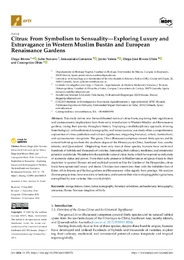Resumen :
This study delves into the multifaceted realm of citrus fruits, exploring their significance
and socioeconomic implications from their early introduction toWestern Muslim and Renaissance
gardens, tracing their journey throughout history. Employing a multidisciplinary approach, drawing
from biological, archaeobotanical, iconographic, and textual sources, our study offers a comprehensive
exploration of citrus symbolism and cultural significance, integrating historical, artistic, horticultural,
and socioeconomic viewpoints. The genus Citrus (Rutaceae) comprises around thirty species and its
natural habitat spans from the southern slopes of the Himalayas to China, Southeast Asia, nearby
islands, and Queensland. Originating from only four of these species, humans have cultivated
hundreds of hybrids and thousands of varieties, harnessing their culinary, medicinal, and ornamental
potential worldwide. We delve into the symbolic value of citrus fruits, which have served as indicators
of economic status and power. From their early presence in Mediterranean religious rituals to their
depiction in opulent Roman art and mythical narratives like the Garden of the Hesperides, citrus
fruits have epitomized luxury and desire. Christian lore intertwines them with the forbidden fruit of
Eden, while Islamic and Sicilian gardens and Renaissance villas signify their prestige. We analyze
diverse perspectives, from moralists to hedonists, and examine their role in shaping global agriculture,
exemplified by rare varieties like aurantii foetiferi.
|
 La licencia se describe como: Atribución-NonComercial-NoDerivada 4.0 Internacional.
La licencia se describe como: Atribución-NonComercial-NoDerivada 4.0 Internacional.
.png)
